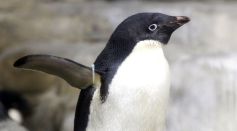ENVIRONMENT & CLIMATE

Penguins Added to the List of Self-Aware Animals After Passing the Mirror Test

Woolly Mammoth Revival: Extinct Elephant Species Possibly Walk Back With Developing Hybrids in the Next Five Years

Ancient Egypt Discoveries That Left an Imprint in 2022

Underwater 'Marimo' Algae Balls' Overexposure to Sunlight Poses Possible Decline of Endangered Species, Study Reveals

Diplodocus Dinosaurs' Tail Believed To Generate Sonic Boom in Single Whip Protecting Them From Predators

How Sequins Contribute to Plastic Pollution

Preserved Last Meal: Mammal's Foot Found Inside Winged Microraptor Dinosaur Stomach, Preserved for 100 Million Years

Animation in Palaeolithic: Oldest Animations Present Diverse Artworks Resembling Modern Cinemas

Dinosaur Dominance Drive by Climate Change: Shifts in Global Climate Profited Earliest Giant Reptiles

Toxoplasmosis Brain Parasite Swarms Grey Wolves' Mind, Manipulating Leadership With Risk-Taking Behaviors
Protecting One of the World's Tiniest Geckos: Extremely Rare Paper Clip-sized Lizard Only Lives in a Tiny Remote Caribbean Island

Average Lifespan of a Dog is 11.2 Years, But Lifespan Varies Across Breeds

Flightless or Not: With Flying, Pink Colors Do Flamingos Fly? Here's What Science Says

Spy Drone in Australia Watches Shore-Bound Sharks, Monitoring Beach-Goers and Swimming Species
Most Popular

Universe Origin Revealed: Exploring the Latest Big Bang Science Theories and Discoveries

Big Bang Physics and Cosmology: Can Science Really Explain the Origins of the Universe?

Space Tourism Future: How Commercial Space Travel Will Transform Civilian Exploration

Tree Communication Explained: How Underground Fungi Networks Connect Entire Forests





